Unit 12 Innovation Lesson 1 Grammar课件(共28张PPT) 2024-2025学年高二英语北师版(2019)选择性必修4
文档属性
| 名称 | Unit 12 Innovation Lesson 1 Grammar课件(共28张PPT) 2024-2025学年高二英语北师版(2019)选择性必修4 |
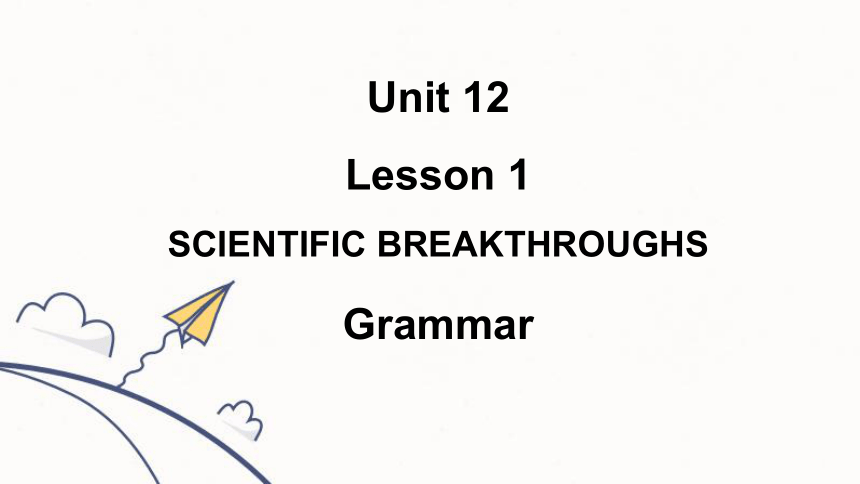
|
|
| 格式 | pptx | ||
| 文件大小 | 1.9MB | ||
| 资源类型 | 教案 | ||
| 版本资源 | 北师大版(2019) | ||
| 科目 | 英语 | ||
| 更新时间 | 2025-04-29 09:32:38 | ||
图片预览


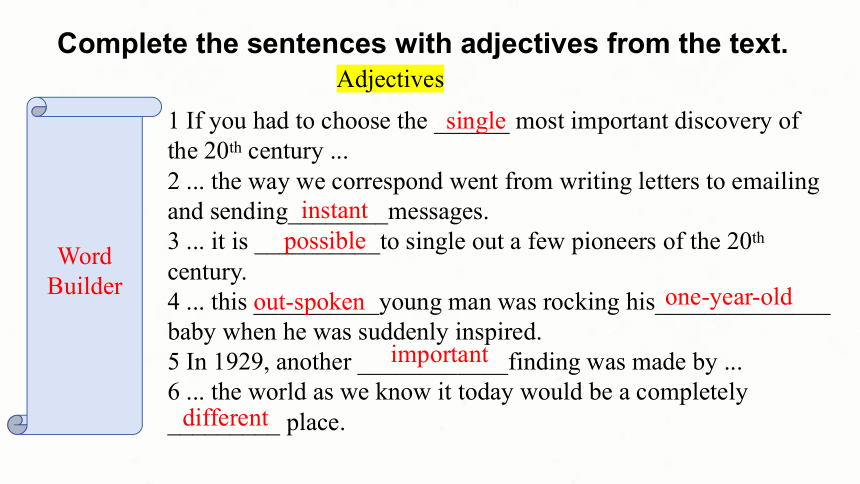
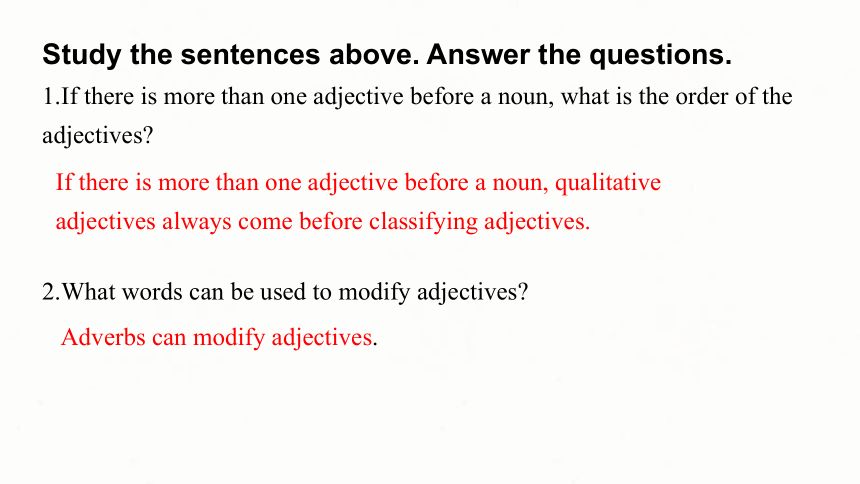
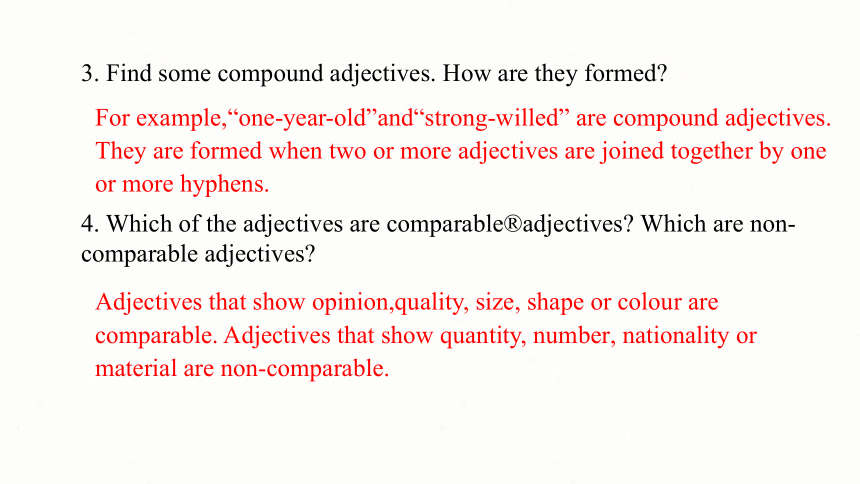
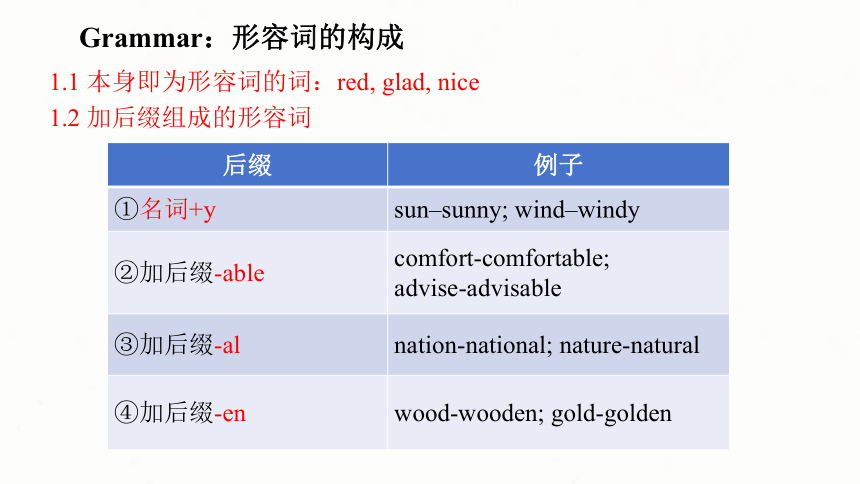
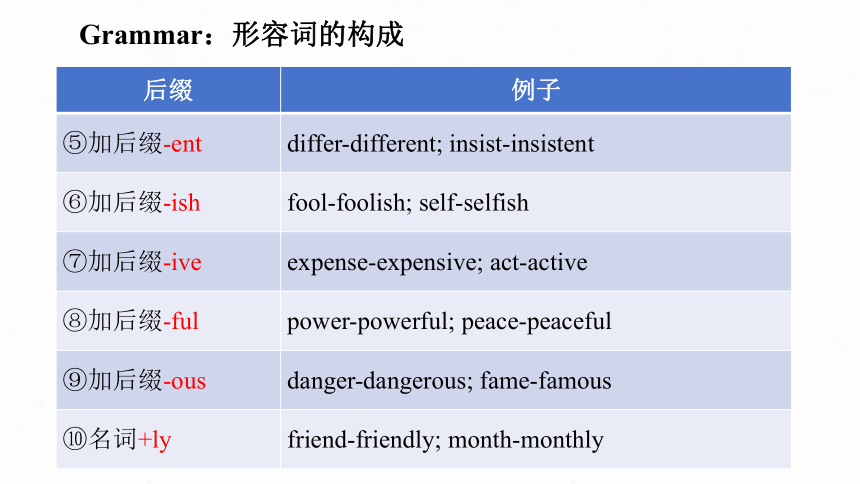

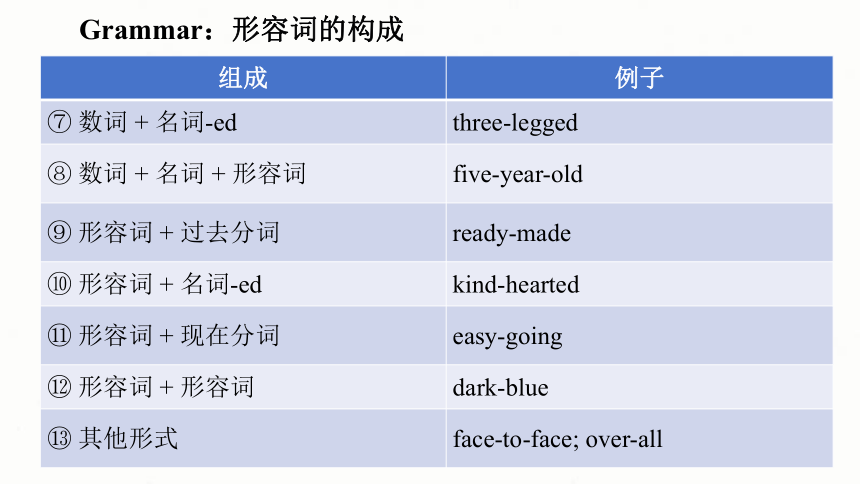
文档简介
(共28张PPT)
Grammar
Unit 12
Lesson 1
SCIENTIFIC BREAKTHROUGHS
Master the formation、function and position of adjectives.
Learning objectives
Complete the sentences with adjectives from the text.
Adjectives
1 If you had to choose the ______ most important discovery of the 20th century ...
2 ... the way we correspond went from writing letters to emailing and sending________messages.
3 ... it is __________to single out a few pioneers of the 20th
century.
4 ... this __________young man was rocking his______________ baby when he was suddenly inspired.
5 In 1929, another ____________finding was made by ...
6 ... the world as we know it today would be a completely _________ place.
single
instant
possible
out-spoken
one-year-old
important
different
Word Builder
Study the sentences above. Answer the questions.
1.If there is more than one adjective before a noun, what is the order of the adjectives
2.What words can be used to modify adjectives
If there is more than one adjective before a noun, qualitative adjectives always come before classifying adjectives.
Adverbs can modify adjectives.
3. Find some compound adjectives. How are they formed
4. Which of the adjectives are comparable adjectives Which are non-comparable adjectives
For example,“one-year-old”and“strong-willed” are compound adjectives. They are formed when two or more adjectives are joined together by one or more hyphens.
Adjectives that show opinion,quality, size, shape or colour are comparable. Adjectives that show quantity, number, nationality or material are non-comparable.
后缀 例子
①名词+y sun–sunny; wind–windy
②加后缀-able comfort-comfortable;
advise-advisable
③加后缀-al nation-national; nature-natural
④加后缀-en wood-wooden; gold-golden
1.1 本身即为形容词的词:red, glad, nice
1.2 加后缀组成的形容词
Grammar:形容词的构成
后缀 例子
⑤加后缀-ent differ-different; insist-insistent
⑥加后缀-ish fool-foolish; self-selfish
⑦加后缀-ive expense-expensive; act-active
⑧加后缀-ful power-powerful; peace-peaceful
⑨加后缀-ous danger-dangerous; fame-famous
⑩名词+ly friend-friendly; month-monthly
Grammar:形容词的构成
1.3 复合形容词的构成
组成 例子
① 副词 + 现在分词 hard-working
② 副词 + 过去分词 well-educated
③ 名词 + 过去分词 man-made
④ 名词 + 现在分词 peace-loving
⑤ 名词 + 形容词 world-famous
⑥ 数词 + 名词 five-star
Grammar:形容词的构成
组成 例子
⑦ 数词 + 名词-ed three-legged
⑧ 数词 + 名词 + 形容词 five-year-old
⑨ 形容词 + 过去分词 ready-made
⑩ 形容词 + 名词-ed kind-hearted
形容词 + 现在分词 easy-going
形容词 + 形容词 dark-blue
其他形式 face-to-face; over-all
Grammar:形容词的构成
Join one word in box A with one word in box B to form a compound adjective.Then complete the sentences with the compound adjectives.
A. hand well early old all hard high
B.known made night morning fashioned hitting fat
early-morning
hand—made
well-known
high-fat
hard-hitting
all-night
old-fashioned
Join one word in box A with one word in box B to form a compound adjective.Then complete the sentences with the compound adjectives.
A. hand well early old all hard high
B.known made night morning fashioned hitting fat
early-morning
hand—made
well-known
high-fat
hard-hitting
all-night
old-fashioned
1.4 分词形容词
现在分词构成的形容词 修饰事物, 常译为“令人……的” 过去分词构成的形容词
修饰人,
常译为“感到……的”
annoying, boring, exciting, frightening, disappointing, discouraging, embarrassing annoyed, bored, excited, frightened, disappointed, discouraged, embarrassed
Grammar:形容词的构成
“名词 + 分词”构成的形容词,究竟是用 -ing 形式还是用 -ed 形式的分词,要看复合词与被修饰词的关系,如 peace-loving people。
限定词 1 2
冠词的限定词(放在冠词前) 冠词 / 指示代词 / 所有格 /
不定代词等
both, such the, a(n), your, Tom’s, this, that, these, those, another, some, any
当多个形容词同时出现作定语时,一般按照各形容词与被修饰词之间的紧密程度排列,其排列顺序如下:
Grammar:形容词的位置
数量词 3 4
序数词 基数词
first, second, third, fourth, fifth one, two, three, four
five
Grammar:形容词的位置
形容词 5 6 7 8 9 10 11
性质状态 大小 / 长短 / 形状 新旧 / 温度 颜色 国籍 材料 用途 / 类别
kind fine good sick large small long short round old new cool hot red blue white green Chinese English Japanese America iron stone silk chemical
medical
Grammar:形容词的位置
巧记顺口溜:
限定描绘大长高,形状年龄和新老,颜色国籍跟材料,作用类别往后靠。
形容词的句法功能
Worse still, we got lost in the dark.
Purple is the in colour this spring.
找出下列句中形容词并说明其在句中充当的成分
Everything useful in the house was taken away by him by force.
She beat the poor boy black and blue.
He walked in the wind, lonely and hungry.
Words are plentiful but deeds are precious.
adj做表语,位于系动词之后
adj做前置定语
adj做后置定语
adj做宾语补足语
adj做状语
adj做独立成分
表示人/事物的特征
be 动词
感官动词:look, smell, taste, sound, feel.
3.表变化:become, grow, get, go, turn.
4.表保持延续:keep, remain, stay.
5.其他:fall, appear, seem, prove.
get sb. interested make sb. happy
keep sb. separate consider sth. true
find sb. unhappy prove sth. true
注 意 考 点
②形容词做宾补和状语
1. We must keep the windows ________ (open) to let the fresh air in.
open
2. He is very popular among his students as he always tries to make them ___________ (interest) in his lectures.
interested
③ 形容词作状语
adj作状语对主语的性质或状态加以说明
Strong, proud and united, the people of Wuhan are the modern heroes of China.
the people of Wuhan
注 意 考 点
①形容词后置:表语形容词如alive, alone, awake, asleep等放在名词之后;形容词修饰something等不定代词和表示尺寸、距离时,也后置。
Those alive should memorize the dead forever.
****既可前置又可后置的形容词;做前置定语和后置定语意义不同
the people present the present time
the people involved an involved sentence
all party concerned a concerned look
在场的
目前的;现在的
卷入/涉及的
复杂的
有关的
担忧的
构成 原级 比较级 最高级
一般加-er和-est strong stronger strongest
以字母 e 结尾只加-r,-st late later latest
以一个辅音字母结尾的重读闭音节,双写这一辅音字母后再加-er,-est glad hot thin gladder hotter thinner gladdest
hottest
thinnest
3.1 规则变化
Grammar:形容词的比较级和最高级
构成 原级 比较级 最高级
以“辅音字母+y”结尾的词,将y变为i,再加-er,-est angry merry ugly early angrier merrier uglier earlier angriest
merriest
ugliest
earliest
其他双音节词和多音节词,在词前加more或most enthusiastic more enthusiastic most enthusiastic
Grammar:形容词的比较级和最高级
构成 原级 比较级 最高级
以“元音字母+y”结尾的词,直接加 -er,-est gray grayer grayest
有少数几个双音节以及以-er以及-le结尾的词,有两种形式 common clever simple commoner / more common; cleverer / more clever; simpler / more simple commonest / most common;
cleverest / most clever;
simplest / most simple
Grammar:形容词的比较级和最高级
构成 原级 比较级 最高级
“劣等”比较,在 adj 原型前加 less / least kind useful less kind less useful least kind
least useful
复合式形容词比较等级 well-known better-known best-known
Grammar:形容词的比较级和最高级
3.2 不规则变化
Grammar:形容词的比较级和最高级
原级 比较级 最高级
good / well better best
bad / ill worse worst
little less least
much / many more most
Grammar:形容词的比较级和最高级
原级 比较级 最高级
far farther / further farthest / furthest
old older / elder oldest / eldest
late later latest
① older, oldest 指时间、年龄、年代的长短,既可指人,又可指物。
② elder, eldest 指家庭成员的长幼顺序。
--------------------------------------------------------------
① farther, farthest 表示距离的远
② further, furthest 表示程度
含形容词比较级的习语 more or less 或多或少 sooner or later 迟早 much less / still less 更不必说 more than once / often 不止一次 once more / once again 再一遍 more than 超过;非常;不仅仅 The work is more or less finished.
More than one person was killed in that accident.
Grammar:含形容词比较词、最高级的习语
含形容词最高级的习语 at (the) latest 最迟 at (the) most 最多,不超过 at least 至少 at best 充其量 do one’s best 尽力 for the most part 多半,通常 make the best / most of 充分利用 not in the least / not at all 一点也不 As long as you do your best, we’ll be happy.
Grammar:含形容词比较词、最高级的习语
Summary
1.They also shared with us many __________(tradition)stories about Hawaii that were ______ (huge)popular with tourists.
2. According to the World Bank, China accounts for about 30 percent of total ______ (globe)fertilizer consumption.
3. The weather in England is quite ___________ (change) .
traditional
hugely
global
changeable
4. This app _______ (able) people to enjoy reading and keep good habits.
enable
实 战 演 练
Exercise
5. It was __________ (consider) of Michael to inform us of his delay in case we got worried.
6. Instead of blaming the child who had broken the vase, she gave him a ________(tolerance) smile and let him go.
considerate
tolerant
Grammar
Unit 12
Lesson 1
SCIENTIFIC BREAKTHROUGHS
Master the formation、function and position of adjectives.
Learning objectives
Complete the sentences with adjectives from the text.
Adjectives
1 If you had to choose the ______ most important discovery of the 20th century ...
2 ... the way we correspond went from writing letters to emailing and sending________messages.
3 ... it is __________to single out a few pioneers of the 20th
century.
4 ... this __________young man was rocking his______________ baby when he was suddenly inspired.
5 In 1929, another ____________finding was made by ...
6 ... the world as we know it today would be a completely _________ place.
single
instant
possible
out-spoken
one-year-old
important
different
Word Builder
Study the sentences above. Answer the questions.
1.If there is more than one adjective before a noun, what is the order of the adjectives
2.What words can be used to modify adjectives
If there is more than one adjective before a noun, qualitative adjectives always come before classifying adjectives.
Adverbs can modify adjectives.
3. Find some compound adjectives. How are they formed
4. Which of the adjectives are comparable adjectives Which are non-comparable adjectives
For example,“one-year-old”and“strong-willed” are compound adjectives. They are formed when two or more adjectives are joined together by one or more hyphens.
Adjectives that show opinion,quality, size, shape or colour are comparable. Adjectives that show quantity, number, nationality or material are non-comparable.
后缀 例子
①名词+y sun–sunny; wind–windy
②加后缀-able comfort-comfortable;
advise-advisable
③加后缀-al nation-national; nature-natural
④加后缀-en wood-wooden; gold-golden
1.1 本身即为形容词的词:red, glad, nice
1.2 加后缀组成的形容词
Grammar:形容词的构成
后缀 例子
⑤加后缀-ent differ-different; insist-insistent
⑥加后缀-ish fool-foolish; self-selfish
⑦加后缀-ive expense-expensive; act-active
⑧加后缀-ful power-powerful; peace-peaceful
⑨加后缀-ous danger-dangerous; fame-famous
⑩名词+ly friend-friendly; month-monthly
Grammar:形容词的构成
1.3 复合形容词的构成
组成 例子
① 副词 + 现在分词 hard-working
② 副词 + 过去分词 well-educated
③ 名词 + 过去分词 man-made
④ 名词 + 现在分词 peace-loving
⑤ 名词 + 形容词 world-famous
⑥ 数词 + 名词 five-star
Grammar:形容词的构成
组成 例子
⑦ 数词 + 名词-ed three-legged
⑧ 数词 + 名词 + 形容词 five-year-old
⑨ 形容词 + 过去分词 ready-made
⑩ 形容词 + 名词-ed kind-hearted
形容词 + 现在分词 easy-going
形容词 + 形容词 dark-blue
其他形式 face-to-face; over-all
Grammar:形容词的构成
Join one word in box A with one word in box B to form a compound adjective.Then complete the sentences with the compound adjectives.
A. hand well early old all hard high
B.known made night morning fashioned hitting fat
early-morning
hand—made
well-known
high-fat
hard-hitting
all-night
old-fashioned
Join one word in box A with one word in box B to form a compound adjective.Then complete the sentences with the compound adjectives.
A. hand well early old all hard high
B.known made night morning fashioned hitting fat
early-morning
hand—made
well-known
high-fat
hard-hitting
all-night
old-fashioned
1.4 分词形容词
现在分词构成的形容词 修饰事物, 常译为“令人……的” 过去分词构成的形容词
修饰人,
常译为“感到……的”
annoying, boring, exciting, frightening, disappointing, discouraging, embarrassing annoyed, bored, excited, frightened, disappointed, discouraged, embarrassed
Grammar:形容词的构成
“名词 + 分词”构成的形容词,究竟是用 -ing 形式还是用 -ed 形式的分词,要看复合词与被修饰词的关系,如 peace-loving people。
限定词 1 2
冠词的限定词(放在冠词前) 冠词 / 指示代词 / 所有格 /
不定代词等
both, such the, a(n), your, Tom’s, this, that, these, those, another, some, any
当多个形容词同时出现作定语时,一般按照各形容词与被修饰词之间的紧密程度排列,其排列顺序如下:
Grammar:形容词的位置
数量词 3 4
序数词 基数词
first, second, third, fourth, fifth one, two, three, four
five
Grammar:形容词的位置
形容词 5 6 7 8 9 10 11
性质状态 大小 / 长短 / 形状 新旧 / 温度 颜色 国籍 材料 用途 / 类别
kind fine good sick large small long short round old new cool hot red blue white green Chinese English Japanese America iron stone silk chemical
medical
Grammar:形容词的位置
巧记顺口溜:
限定描绘大长高,形状年龄和新老,颜色国籍跟材料,作用类别往后靠。
形容词的句法功能
Worse still, we got lost in the dark.
Purple is the in colour this spring.
找出下列句中形容词并说明其在句中充当的成分
Everything useful in the house was taken away by him by force.
She beat the poor boy black and blue.
He walked in the wind, lonely and hungry.
Words are plentiful but deeds are precious.
adj做表语,位于系动词之后
adj做前置定语
adj做后置定语
adj做宾语补足语
adj做状语
adj做独立成分
表示人/事物的特征
be 动词
感官动词:look, smell, taste, sound, feel.
3.表变化:become, grow, get, go, turn.
4.表保持延续:keep, remain, stay.
5.其他:fall, appear, seem, prove.
get sb. interested make sb. happy
keep sb. separate consider sth. true
find sb. unhappy prove sth. true
注 意 考 点
②形容词做宾补和状语
1. We must keep the windows ________ (open) to let the fresh air in.
open
2. He is very popular among his students as he always tries to make them ___________ (interest) in his lectures.
interested
③ 形容词作状语
adj作状语对主语的性质或状态加以说明
Strong, proud and united, the people of Wuhan are the modern heroes of China.
the people of Wuhan
注 意 考 点
①形容词后置:表语形容词如alive, alone, awake, asleep等放在名词之后;形容词修饰something等不定代词和表示尺寸、距离时,也后置。
Those alive should memorize the dead forever.
****既可前置又可后置的形容词;做前置定语和后置定语意义不同
the people present the present time
the people involved an involved sentence
all party concerned a concerned look
在场的
目前的;现在的
卷入/涉及的
复杂的
有关的
担忧的
构成 原级 比较级 最高级
一般加-er和-est strong stronger strongest
以字母 e 结尾只加-r,-st late later latest
以一个辅音字母结尾的重读闭音节,双写这一辅音字母后再加-er,-est glad hot thin gladder hotter thinner gladdest
hottest
thinnest
3.1 规则变化
Grammar:形容词的比较级和最高级
构成 原级 比较级 最高级
以“辅音字母+y”结尾的词,将y变为i,再加-er,-est angry merry ugly early angrier merrier uglier earlier angriest
merriest
ugliest
earliest
其他双音节词和多音节词,在词前加more或most enthusiastic more enthusiastic most enthusiastic
Grammar:形容词的比较级和最高级
构成 原级 比较级 最高级
以“元音字母+y”结尾的词,直接加 -er,-est gray grayer grayest
有少数几个双音节以及以-er以及-le结尾的词,有两种形式 common clever simple commoner / more common; cleverer / more clever; simpler / more simple commonest / most common;
cleverest / most clever;
simplest / most simple
Grammar:形容词的比较级和最高级
构成 原级 比较级 最高级
“劣等”比较,在 adj 原型前加 less / least kind useful less kind less useful least kind
least useful
复合式形容词比较等级 well-known better-known best-known
Grammar:形容词的比较级和最高级
3.2 不规则变化
Grammar:形容词的比较级和最高级
原级 比较级 最高级
good / well better best
bad / ill worse worst
little less least
much / many more most
Grammar:形容词的比较级和最高级
原级 比较级 最高级
far farther / further farthest / furthest
old older / elder oldest / eldest
late later latest
① older, oldest 指时间、年龄、年代的长短,既可指人,又可指物。
② elder, eldest 指家庭成员的长幼顺序。
--------------------------------------------------------------
① farther, farthest 表示距离的远
② further, furthest 表示程度
含形容词比较级的习语 more or less 或多或少 sooner or later 迟早 much less / still less 更不必说 more than once / often 不止一次 once more / once again 再一遍 more than 超过;非常;不仅仅 The work is more or less finished.
More than one person was killed in that accident.
Grammar:含形容词比较词、最高级的习语
含形容词最高级的习语 at (the) latest 最迟 at (the) most 最多,不超过 at least 至少 at best 充其量 do one’s best 尽力 for the most part 多半,通常 make the best / most of 充分利用 not in the least / not at all 一点也不 As long as you do your best, we’ll be happy.
Grammar:含形容词比较词、最高级的习语
Summary
1.They also shared with us many __________(tradition)stories about Hawaii that were ______ (huge)popular with tourists.
2. According to the World Bank, China accounts for about 30 percent of total ______ (globe)fertilizer consumption.
3. The weather in England is quite ___________ (change) .
traditional
hugely
global
changeable
4. This app _______ (able) people to enjoy reading and keep good habits.
enable
实 战 演 练
Exercise
5. It was __________ (consider) of Michael to inform us of his delay in case we got worried.
6. Instead of blaming the child who had broken the vase, she gave him a ________(tolerance) smile and let him go.
considerate
tolerant
同课章节目录
- Unit 10 Connections
- Lesson 1 How Closely Connected Are We?
- Lesson 2 Community Spirit
- Lesson 3 Anne of Green Gables
- Unit 11 Conflict And Compromise
- Lesson 1 Living In a Community
- Lesson 2 Dealing with Conflict
- Lesson 3 War Memories
- Unit 12 Innovation
- Lesson 1 Scientific Breakthroughs
- Lesson 2 Aha Moment
- Lesson 3 Stephen Hawking
